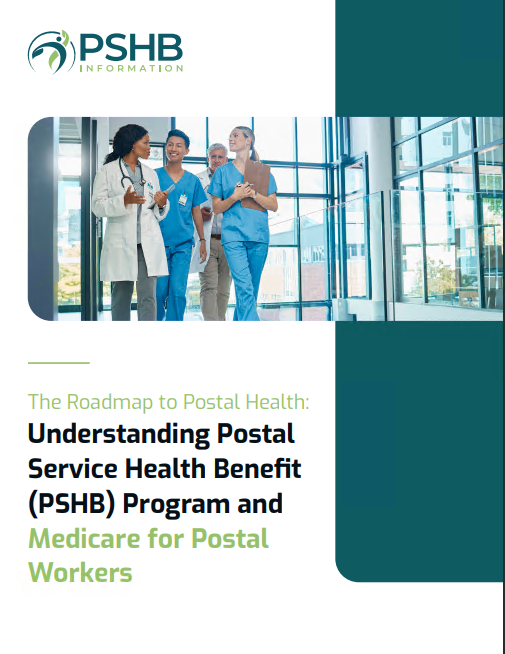Key Takeaways
-
Adding Medicare to your PSHB plan can change how coinsurance costs apply—and ignoring this shift could cost you far more than expected.
-
Many PSHB plans reduce or eliminate coinsurance for enrollees who are also enrolled in Medicare Part B, making coordination essential for lower out-of-pocket expenses.
The Layered Reality of PSHB and Medicare Together
If you’re a Postal Service retiree—or about to become one—you’ve likely heard that combining Medicare with your Postal Service Health Benefits (PSHB) plan can enhance your coverage. While that’s true, it doesn’t mean everything is suddenly paid for. One cost that often slips through the cracks in your planning? Coinsurance.
Coinsurance isn’t the same as a copayment. Unlike a fixed fee, it’s a percentage of the cost of a covered service. And when you combine Medicare and your PSHB plan, understanding who pays what becomes essential. If you’re not paying attention, that percentage can turn into hundreds—or even thousands—out of your own pocket.
What Coinsurance Actually Means in Your PSHB Plan
In 2025, most PSHB plans still use a cost-sharing model for certain services. This means:
-
In-network coinsurance rates generally range from 10% to 30%.
-
Out-of-network coinsurance can be much higher, sometimes reaching 40% to 50%.
-
Coinsurance applies to services like specialist visits, lab work, hospital stays, durable medical equipment, and outpatient surgeries.
These percentages may seem manageable—until you apply them to actual service costs. A 20% coinsurance on a $4,000 procedure means you’re responsible for $800. Without Medicare Part B backing you up, that cost hits you directly.
The Medicare Coordination Factor
When you add Medicare Part B to the mix, something important happens: coordination of benefits. Medicare generally becomes the primary payer, and your PSHB plan becomes secondary. That means:
-
Medicare pays first (usually 80% of covered services).
-
Your PSHB plan may pay some or all of the remaining 20%.
-
In some cases, your coinsurance is reduced—or eliminated altogether—when both plans are active.
But this benefit only works if you’re actually enrolled in Medicare Part B. If you opt out, your PSHB plan acts as your primary coverage and you’re responsible for a much larger share of coinsurance.
Medicare Enrollment Isn’t Optional for Most Retirees Anymore
As of January 1, 2025, most Medicare-eligible Postal Service retirees and their family members must enroll in Medicare Part B to maintain PSHB coverage. This new integration rule means your coinsurance landscape shifts significantly—whether you’ve realized it or not.
Here’s what it means for you:
-
You must enroll in Part B if you’re eligible and not exempt (some pre-2025 retirees are excluded).
-
If you fail to enroll, your PSHB plan may not pay as a secondary, leaving you with full coinsurance costs.
-
This rule affects your budget not just now, but for every medical event going forward.
How Coinsurance Adds Up With or Without Medicare
Let’s break it down with general cost categories that apply in PSHB plans:
Outpatient Surgery
-
Without Medicare: 20%–30% coinsurance on total billed amount.
-
With Medicare Part B: Medicare pays 80%; PSHB often covers the rest, leaving little to no coinsurance.
Diagnostic Tests and Imaging
-
Without Medicare: Expect coinsurance ranging from $100 to $400 per service.
-
With Medicare: You may owe nothing beyond your Part B premium and deductible.
Durable Medical Equipment
-
Without Medicare: You could pay 30% of the full retail cost.
-
With Medicare: You typically owe 20% of the Medicare-approved amount; PSHB can cover that 20% if coordinated.
Over time, these seemingly small amounts snowball—especially if you face recurring treatments or chronic conditions.
Don’t Confuse Copayments with Coinsurance
One common misconception is that Medicare + PSHB coverage means every cost becomes a copay. But coinsurance is different:
-
Copayment is a fixed dollar amount (e.g., $40 for a specialist).
-
Coinsurance is a percentage of the service charge (e.g., 20% of $1,000 = $200).
While many PSHB plans cap copays, coinsurance does not always come with a dollar limit—unless you’ve hit your out-of-pocket maximum.
What About the Out-of-Pocket Maximum?
PSHB plans in 2025 do include out-of-pocket maximums—typically:
-
$7,500 for Self Only (in-network).
-
$15,000 for Self Plus One or Self & Family (in-network).
Once you reach this ceiling, your plan generally covers 100% of in-network services. But until then, coinsurance keeps chipping away at your finances. Adding Medicare can dramatically slow that progression, keeping you well below those thresholds.
Why Some Retirees Skip Medicare—and Why That Can Backfire
Some Postal retirees choose not to enroll in Medicare Part B, often to avoid paying the monthly premium. But in doing so, they miss out on key benefits that can dramatically reduce coinsurance.
Here’s what that decision can cost:
-
No secondary payer: PSHB plans won’t act as second payer unless Medicare Part B is primary.
-
No reduced coinsurance: You’re billed at full PSHB coinsurance rates.
-
Potential late enrollment penalties: Waiting to sign up for Medicare can trigger permanent penalties, adding even more to your costs.
In short, skipping Medicare may save you money upfront—but cost you far more in the long run.
Timing Matters: When to Enroll to Avoid Gaps
If you’re approaching age 65—or already there—timing your enrollment in Medicare is key. You generally have a 7-month window:
-
3 months before your 65th birthday
-
The month of your birthday
-
3 months after
Enrolling during this Initial Enrollment Period ensures you won’t face coverage gaps or late penalties. If you miss this window, you may have to wait for the General Enrollment Period (January 1 to March 31), with coverage starting in July—and penalties adding up.
For PSHB retirees, missing this timing window doesn’t just lead to Medicare penalties—it could also increase your PSHB coinsurance exposure during the gap months.
Reviewing Your Plan’s Medicare Coordination Benefits
Not every PSHB plan handles Medicare integration the same way. That’s why it’s vital to:
-
Review your plan brochure each year during the November–December Open Season.
-
Look for sections labeled “Medicare and this Plan” or “Coordination of Benefits.”
-
Check whether your plan reduces or eliminates coinsurance for Medicare enrollees.
In 2025, many plans offer reduced or waived deductibles, lower copays, and limited or no coinsurance—but only if you’re actively enrolled in Medicare Part B.
The Postal Service Prescription Drug Coverage Tie-In
Another benefit of PSHB-Medicare coordination involves your prescription drugs. If you’re Medicare-eligible and enrolled in a PSHB plan, you’re automatically covered by a Medicare Part D Employer Group Waiver Plan (EGWP). Here’s why that matters:
-
There’s now a $2,000 annual cap on out-of-pocket drug costs under Part D.
-
Without Medicare, prescription drug coinsurance under PSHB alone could easily exceed that.
This alone can significantly reduce your medication-related coinsurance, especially if you take multiple high-cost prescriptions.
Why You Shouldn’t Wait for a Medical Event to Care About Coinsurance
Coinsurance rarely feels urgent—until it suddenly is. A fall, illness, or unexpected surgery can leave you facing bills you didn’t anticipate. But by coordinating PSHB with Medicare ahead of time, you:
-
Protect yourself from full coinsurance exposure.
-
Allow your PSHB plan to act as a true secondary payer.
-
Get access to cost-sharing benefits that aren’t retroactive if you delay enrollment.
The takeaway? Be proactive—not reactive.
The Real Value of Medicare in Your PSHB Strategy
You earned your Postal Service retirement benefits through decades of service. Medicare isn’t just another plan—it’s a critical piece of your cost-protection strategy.
-
Medicare Part B enrollment is more than just a requirement—it’s a shield against escalating coinsurance.
-
Together, PSHB and Medicare form a system that can limit your exposure to large, unpredictable medical bills.
But it only works if you understand how they interact—and act accordingly.
Ready to Rethink Your Coinsurance Exposure?
The best time to evaluate your coinsurance strategy is before it becomes a financial burden. The integration of Medicare and PSHB coverage in 2025 makes it easier than ever to reduce your out-of-pocket costs—if you enroll in Medicare and choose a plan that coordinates well.
If you’re unsure where to start, get in touch with a licensed agent listed on this website. They can help you:
-
Compare how coinsurance works with and without Medicare.
-
Identify PSHB plans that offer the strongest Medicare coordination.
-
Understand timelines, penalties, and what actions to take next.
Being proactive today could mean thousands saved tomorrow.






